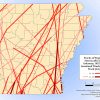calsfoundation@cals.org
Hurricane Katrina/Rita Evacuees
Following the destruction wrought by Hurricane Katrina in late August 2005, the evacuated population of New Orleans, Louisiana, was redistributed throughout America to forty-five states and the District of Columbia. As expected, states in the South took in more of the displaced than the rest of the country. An estimated eighty percent of Katrina evacuees temporarily relocated to Mississippi, Alabama, Texas, Tennessee, Georgia, Florida, or Arkansas. Arkansas received approximately 75,000 evacuees, and Texas initially took in more than 250,000 at the Houston Astrodome, the Reliant Complex, the George R. Brown Convention Center, and other sites in southern Texas. However, no state experienced a population increase larger than Arkansas, whose population jumped 2.5 percent after the evacuees arrived.
The first evacuees arrived by car, bus, train, or plane in advance of the storm, seeking out friends and relatives in Arkansas, or trying to outrun the bad weather by relocating as far away from the projected landfall as possible. These people did not bring along many personal effects, as they were expecting to be away for about three days and then return home. Thus, their preparation for the trip—hastily arranged due to possible evacuation orders—did not leave them with resources to survive a long evacuation period. After assessing the scope of Katrina’s damage to infrastructure and neighborhoods, evacuees learned that their time away from home would be longer than originally planned.
Government officials in Arkansas responded to this initial influx of visitors by supplying shelter and lodging information at Arkansas Information Centers in Lake Village (Chicot County), Helena-West Helena (Phillips County), Texarkana (Miller County), and El Dorado (Union County). At the direction of Governor Mike Huckabee, the Arkansas National Guard opened readiness centers in Searcy (White County) and Crossett (Ashley County) to provide shelter, as well as donating cots and blankets to shelters being set up in West Memphis (Crittenden County), Lake Village, and Hot Springs (Garland County). The governor released $75,000 to assist fourteen shelters in the Delta and southern counties. The State of Arkansas also established K.A.R.E., the Katrina Assistance Relief Effort, a toll-free telephone number and website for evacuees seeking assistance. The State also provided deep discounts on spaces at its state parks, waiving pet restrictions and hunting fees, and allowing evacuees to stay even if other travelers had confirmed reservations.
After Katrina’s landfall, at least three waves of refugees were processed at Fort Chaffee near Fort Smith (Sebastian County). On September 4, 2005, hundreds of buses arrived, disembarking about 10,000 passengers picked up at the Louisiana Superdome, the Ernest N. Morial Convention Center, and points in Mississippi and Texas. Sixteen days later, Hurricane Rita formed in the Gulf and grew into a powerful hurricane with a projected landfall in Texas. U.S. Department of Homeland Security officials removed about 4,000 Katrina evacuees from southern Texas venues such as the Houston Astrodome and the Reliant Complex; approximately 1,100 of these fled to Fort Chaffee to avoid Rita. In addition, buses carrying about 800 people escaping Rita from Lake Charles and DeRidder, Louisiana, also reached Fort Chaffee.
Fort Chaffee’s selection as an intake center was likely due to its long history of serving the needs of displaced populations under duress. In the 1970s, over 50,000 Indochinese refugees from the Vietnam War were welcomed to America at Chaffee. The fort was also a temporary home to 25,390 Cubans released by Fidel Castro in 1980. As Katrina approached, the facility would be called upon again to deliver aid to the distressed.
Fort Chaffee was set up as an intake center to help the evacuees with the paperwork for any disaster-related assistance they might need, such as applications for Social Security and food stamps, and change-of-address forms. After checking in, the guests were offered a hot meal and places to sleep and to shower. They were free to leave if they had the means or contacts to do so. Some moved on to church camps or other kinds of shelters. If no plans were imminent, they could remain for a time in the barracks, as this portion of the fort had been little used for decades before the two hurricanes.
Evacuees living temporarily in the barracks had certain logistical advantages, as Fort Chaffee served as a buffer between the newcomers and the community. In several states, the relationship between locals and the new arrivals was quickly strained. In Baton Rouge, which overnight became Louisiana’s largest city after Katrina’s landfall, “Katrina rumors” spread among locals, who heard that evacuees were rioting, looting, and committing crimes with impunity. Most of these reports were untrue. It appears that there were fewer instances of false rumors in Arkansas due in part to the buffering effect that the fort provided. Having Fort Chaffee as an intake center also gave Arkansans the benefit of knowing, in large part, who was coming in from New Orleans, what problems they were facing, their socioeconomic status, and how long they might be staying.
The City of Fort Smith arranged for a substantial police presence, shoring up local forces with volunteers from both inside and outside of Arkansas. Ever since Cuban refugees rioted in at Fort Chaffee in 1980, city leaders had been vigilant about allaying locals’ fears that guests at Chaffee may pose elevated risks of criminal victimization.
After the squalor endured at the Superdome and the Morial Convention Center, Katrina evacuees interviewed by historians and journalists were mostly positive about the humane treatment they received at Fort Chaffee. Rumors did spread among the evacuees at the time that they were stateless people who had lost their U.S. citizenship, and this was why their intake at the fort was necessary; this, however, was obviously not true.
State officials arranged for the compassionate care of the medically indigent after the storm. On September 10, the Arkansas National Guard mobilized the Western Arkansas Reserve Valley Medical Corps team to conduct a triage of the thousands temporarily housed at Chaffee. During the triage, the evacuees received medical exams and food/drinks before heading off to their next destination. Approximately 182 shelters across the state accepted patients, and teams of Arkansas Department of Health and Human Services workers were dispatched to determine patient health needs, ensure proper sanitation, and conduct epidemiological surveillance. The Arkansas Department of Health and Human Services worked with Walmart and Walgreens to provide an adequate supply of medications and further partnered with the University of Arkansas for Medical Sciences (UAMS), the Arkansas Hospital Association, and Arkansas Health Education Centers to make healthcare services available.
By September 26, 2005, a total of 2,381 people caught in the Katrina/Rita diaspora still resided in fifty-six evacuation centers in Arkansas. By mid-October, these shelters were mostly cleared. Some of the evacuees moved on to transitional housing while mulling over whether to return to New Orleans. One year later, according to the Bureau of Labor Statistics’ Current Population Survey, less than one percent of the original group that evacuated from New Orleans was still living in Arkansas.
Hope Municipal Airport in Hempstead County became home to the most enduring symbol of the botched federal response to the hurricanes, when about 20,000 Federal Emergency Management Agency (FEMA) trailers were stored there from 2005 to 2011 at an estimated cost of $1.7 million. FEMA originally bought 145,000 manufactured homes for $2.7 billion to provide transitional housing for victims of the hurricanes, but about fifteen percent of them were stranded in Hope due to bureaucratic bungling. FEMA’s own regulations prohibited placing these homes in floodplains, yet almost the entire region affected by the storms was located in a floodplain. A second problem with the trailers was the high levels of the carcinogen formaldehyde detected in them during tests that began in 2006. These problems rendered the trailers virtually worthless in fulfilling their original mission, and thousands of them were subsequently sold for spare parts or for cents on the dollar to families desperate for low-cost housing. Very few of the Katrina and Rita evacuees that relocated to southern Arkansas were able to obtain a trailer from the Hope inventory despite living relatively close to the airport.
Ten years after Katrina’s landfall, about 800 people who fled the 2005 storms still called Arkansas home. Having suffered the horrors of a hurricane, these individuals and families did not want to go through the experience again. Remaining on higher ground in western and northwestern Arkansas made more sense to them than returning to New Orleans, where another storm of Katrina or Rita’s magnitude could put that city in peril again. These survivors expressed genuine gratitude and near universal praise for the kindheartedness and generosity shown to them by Arkansans during the 2005 hurricane season.
For additional information:
Arkansas Department of Health: Responding to the Health Needs of Katrina Evacuees. Little Rock: Arkansas Department of Health and Human Services, 2005.
Bates, Justin. “Hurricane Katrina, Rita Evacuees in Fort Smith Reflect on Lives 10 Years Later.” Southwest Times Record, September 8, 2015.
Blumenthal, Ralph. “Evacuees of One Storm Flee Another in Texas.” New York Times, September 21, 2005, p. 17A.
FEMA’s Manufactured Housing Program: Haste Makes Waste: Hearing before the Committee on Homeland Security and Governmental Affairs, One Hundred Ninth Congress, Second Session, Field Hearing in Hope, Arkansas, April 21, 2006. Washington DC: Government Printing Office, 2007. Online at https://www.gpo.gov/fdsys/pkg/CHRG-109shrg28240/html/CHRG-109shrg28240.htm (accessed October 13, 2020).
Greene, Sara. “Guard Ready for Evacuees.” Arkansas Leader, August 31, 2005.
Groen, Jeffrey, and Anne Povliska. “Hurricane Katrina Evacuees: Who They Are, Where They Are, and How They Are Faring.” Monthly Labor Review 131 (March 2008): 32–51.
Gute, Melissa. “For Some Who Fled Katrina, Arkansas Now Home.” Arkansas Democrat-Gazette, August 30, 2015, pp. 1B, 3B.
Hardy, Benjamin, and David Koon. “After the Flood.” Arkansas Times, September 10, 2015, pp. 14–21. Online at http://www.arktimes.com/arkansas/after-the-flood/Content?oid=4069501 (accessed October 13, 2020).
Lovett, John. “Fort Smith New Home for Hurricane Rita Evacuees.” Southwest Times Record, September 8, 2015.
Penner, D’Ann, and Keith Ferdinand. Overcoming Katrina: African American Voices from the Crescent City and Beyond. New York: Palgrave Macmillan, 2009.
Stan Weeber
McNeese State University
 Divergent Prosperity and the Arc of Reform, 1968–2022
Divergent Prosperity and the Arc of Reform, 1968–2022 Immigration
Immigration Tropical Cyclones
Tropical Cyclones Arkansas National Guard Assisting Hurricane Katrina Evacuees
Arkansas National Guard Assisting Hurricane Katrina Evacuees  FEMA Trailers
FEMA Trailers 




Comments
No comments on this entry yet.